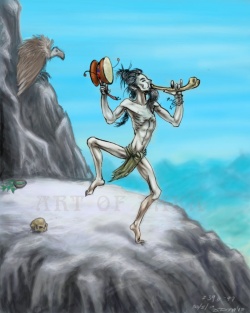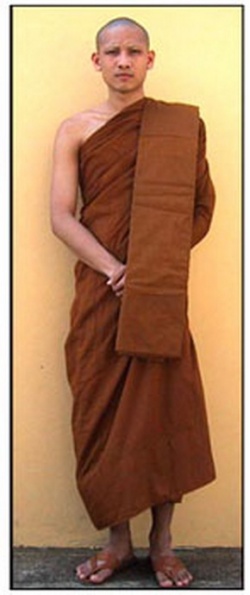The Five Agregates by Rev. Dr. Walpola Sri Rahula
The first is the Aggregate of Matter (Rupakkhandba). In this term 'Aggregate of Matter' are included the traditional Four Great Elements (cattari mahabbutani), namely, solidity, fluidity, heat and motion, and also the Derivatives (upadaya-rupa) of the Four Great Elements. In the term 'Derivatives of Four Great Elements' are included our five material sense-organs, i.e., the faculties of eye, ear, nose, tongue, and body, and their corresponding objects in the external world, i.e., visible form, sound, odour, taste, and tangible things, and also some thoughts or ideas or conceptions which are in the sphere of mind-objects (dharmayatana). Thus the whole realm of matter, both internal and external, is included in the Aggregate of Matter.
The second is the Aggregate of Sensations (Vedanakkhandha). In this group are included all our sensations, pleasant or unpleasant or neutral, experienced through the contact of physical and mental organs with the external world. They are of six kinds: the sensations experienced through the contact of the eye with visible forms, ear with sounds, nose with odour, tongue with taste, body with tangible objects, and mind (which is the sixth faculty in Buddhist Philosophy) with mind-objects or thoughts or ideas. All our physical and mental sensations are included in this group.
A word about what is meant by the term 'Mind' (manas) in Buddhist philosophy may be useful here. It should clearly be understood that mind is not spirit as opposed to matter. It should always be remembered that Buddhism does not recognize a spirit opposed to matter, as is accepted by most other systems of philosophies and religions. Mind is only a faculty or organ (indriya) like the eye or the ear. It can be controlled and developed like any other faculty, and the Buddha speaks quite often of the value of controlling and disciplining these six faculties. The difference between the eye and the mind as faculties is that the former senses the world of colours and visible forms, while the latter senses the world of ideas and thoughts and mental objects. We experience different fields of the world with different senses. We cannot hear colours, but we can see them. Nor can we see sounds, but we can hear them. Thus with our five physical sense organs-eye, ear, nose, tongue, body-we experience only the world of visible forms, sounds, odours, tastes and tangible objects. But these represent only a part of the world, not the whole world. What of ideas and thoughts ? They are also a part of the world. But they cannot be sensed, they cannot be conceived by the faculty of the eye, ear, nose, tongue or body. Yet they can be conceived by another faculty, which is mind. Now ideas and thoughts are not independent of the world experienced by these five physical sense faculties. In fact they depend on, and are conditioned by, physical experiences. Hence a person born blind cannot have ideas of colour, except through the analogy of sounds or some other things experienced through his other faculties. Ideas and thoughts which form a part of the world are thus produced and conditioned by physical experiences and are conceived by the mind. Hence mind (manas) is considered a sense faculty or organ (indriya), like the eye or the ear.
The third is the Aggregate of Perceptions (Sannakkhandha). Like sensations, perceptions also are of six kinds, in relation to six internal faculties and the corresponding six external objects. Like sensations, they are produced through the contact of our six faculties with the external world. It is the perceptions that recognize objects whether physical or mental.
The fourth is the Aggregate of Mental Formations (Samkharak-khandha). In this group are included all volitional activities both good and bad. What is generally known as karma (or kamma) comes under this group. The Buddha's own definition of karma should be remembered here: '0 bhikkhus, it is volition (cetana) that I call karma. Having willed, one acts through body, speech and mind.' Volition is 'mental construction, mental activity. Its function is to direct the mind in the sphere of good, bad or neutral activities.' Just like sensations and perceptions, volition is of six kinds, connected with the six internal faculties and the corresponding six objects (both physical and mental) in the external world. Sensations and perceptions are not volitional actions. They do not produce karmic effects. It is only volitional actions - such as attention (manasikara), will (chanda), determination (adhimokkha), confidence (saddha), concentration (samadhi), wisdom (panna), energy (viriya), desire (raga), repugnance or hate (patigha) ignorance (avijja), conceit (mana), idea of self (sakkaya-difthi) etc. - that can produce karmic effects. There are 52 such mental activities which constitute the Aggregate of Mental Formations.
The fifth is the Aggregate of Consciousness (Vinnanakkhandha) Consciousness is a reaction or response which has one of the six faculties (eye, ear, nose, tongue, body and mind) as its basis, and one of the six corresponding external phenomena (visible form, sound, odour, taste, tangible things and mind-objects, i.e., an idea or thought) as its object. For instance, visual consciousness (cakkhu-vinnana) has the eye as its basis and a visible form as its object. Mental consciousness (mano-vinnana) has the mind (manas) as its basis and a mental object, i.e., an idea or thought (dhamma) as its object. So consciousness is connected with other faculties. Thus, like sensation, perception and volition, consciousness also is of six kinds, in relation to six internal faculties and corresponding six external objects.
It should be clearly understood that consciousness does not recognize an object. It is only a sort of awareness-awareness of the presence of an object. When the eye comes in contact with a colour, for instance blue, visual consciousness arises which simply is awareness of the presence of a colour; but it does not recognize that it is blue. There is no recognition at this stage. It is perception (the third Aggregate discussed above) that recognizes that it is blue. The term 'visual consciousness' is a philosophical expression denoting the same idea as is conveyed by the ordinary word 'seeing. Seeing does not mean recognizing. So are the other forms of consciousness.
It must be repeated here that according to Buddhist philosophy there is no permanent, unchanging spirit which can be considered 'Self', or 'Soul", or 'Ego', as opposed to matter, and that consciousness (vinnana) should not be taken as 'spirit' in opposition to matter. This point has to be particularly emphasized, because a wrong notion that consciousness is a sort of Self or Soul that continues as a permanent substance through life, has persisted from the earliest time to the present day.
One of the Buddha's own disciples, Sari by name, held that the Master taught: 'It is the same consciousness that transmigrates and wanders about.' The Buddha asked him what he meant by 'consciousness'. Sari's reply is classical: 'It is that which expresses, which feels, which experiences the results of good and bad deeds here and there'.
'To whomever, you stupid one', remonstrated the Master, 'have you heard me expounding the doctrine in this manner? Haven't I in many ways explained consciousness as arising out of conditions: that there is no arising of consciousness without conditions.' Then the Buddha went on to explain consciousness in detail: "Conciousness is named according to whatever condition through which it arises: on account of the eye and visible forms arises a consciousness, and it is called visual consciousness; on account of the ear and sounds arises a consciousness, and it is called auditory consciousness; on account of the nose and odours arises a consciousness, and it is called olfactory consciousness; on account of the tongue and tastes arises a consciousness, and it is called gustatory consciousness; on account of the body and tangible objects arises a consciousness, and it is called tactile consciousness; on account of the mind and mind-objects (ideas and thoughts) arises a consciousness, and it is called mental consciousness.'
Then the Buddha explained it further by an illustration: A fire is named according to the material on account of which it burns. A fire may burn on account of wood, and it is called woodfire. It may bum on account of straw, and then it is called strawfire. So consciousness is named according to the condition through which it arises.
Dwelling on this point, Buddhaghosa, the great commentator, explains: '. . . a fire that burns on account of wood burns only when there is a supply, but dies down in that very place when it (the supply) is no longer there, because then the condition has changed, but (the fire) does not cross over to splinters, etc., and become a splinter-fire and so on; even so the consciousness that arises on account of the eye and visible forms arises in that gate of sense organ (i.e., in the eye), only when there is the condition of the eye, visible forms, light and attention, but ceases then and there when it (the condition) is no more there, because then the condition has changed, but (the consciousness) does not cross over to the ear, etc., and become auditory consciousness and so on . . .'
The Buddha declared in unequivocal terms that consciousness depends on matter, sensation, perception and mental formations, and that it cannot exist independently of them. He says:
'Consciousness may exist having matter as its means (rupupayam) matter as its object (rupdrammanam) matter as its support (rupapatittham) and seeking delight it may grow, increase and develop; or consciousness may exist having sensation as its means ... or perception as its means ... or mental formations as its means, mental formations as its object, mental formations as its support, and seeking delight it may grow, increase and develop.
'Were a man to say: I shall show the coming, the going, the passing away, the arising, the growth, the increase or the development of consciousness apart from matter, sensation, perception and mental formations, he would be speaking of something that does not exist.'
Very briefly these are the five Aggregates. What we call a 'being', or an 'individual', or 'I', is only a convenient name or a label given to the combination of these five groups. They are all impermanent, all constantly changing. 'Whatever is impermanent is dukkha' (Yad aniccam tam dukkham). This is the true meaning of the Buddha's words: 'In brief the five Aggregates of Attachment are dukkha.' They are not the same for two consecutive moments. Here A is not equal to A. They are in a flux of momentary arising and disappearing.
'0 Brahmana, it is just like a mountain river, flowing far and swift, taking everything along with it; there is no moment, no instant, no second when it stops flowing, but it goes on flowing and continuing. So Brahmana, is human life, like a mountain river. As the Buddha told Ratthapala: 'The world is in continuous flux and is impermanent.'
One thing disappears, conditioning the appearance of the next in a series of cause and effect. There is no unchanging substance in them. There is nothing behind them that can be called a permanent Self (Atman), individuality, or anything that can in reality be called 'I'. Every one will agree that neither matter, nor sensation, nor perception, nor any one of those mental activities, nor consciousness can really be called 'I'. But when these five physical and mental aggregates which are interdependent are working together in combination as a physio-psychological machine, we get the idea of 'I'. But this is only a false idea, a mental formation, which is nothing but one of those 52 mental formations of the fourth Aggregate which we have just discussed, namely, it is the idea of self (sakkaya-ditthi).
These five Aggregates together, which we popularly call a 'being', are dukkha itself (samkhara-dukkha). There is no other 'being' or 'I', standing behind these five aggregates, who experiences dukkha. As Buddhaghosa says:
'Mere suffering exists, but no sufferer is found; The deeds are, but no doer is found.'
There is no unmoving mover behind the movement. It is only movement. It is not correct to say that life is moving, but life is movement itself. Life and movement are not two different things. In other words, there is no thinker behind the thought. Thought itself is the thinker. If you remove the thought, there is no thinker to be found. Here we cannot fail to notice how this Buddhist view is diametrically opposed to the Cartesian cogito ergo sum: 'I think, therefore I am.'
Now a question may be raised whether life has a beginning. According to the Buddha's teaching the beginning of the life-stream of living beings is unthinkable. The believer in the creation of life by God may be astonished at this reply. But if you were to ask him 'What is the beginning of God ?' he would answer without hesitation 'God has no beginning', and he is not astonished at his own reply. The Buddha says: '0 bhikkhus, this cycle of continuity (samsara) is without a visible end, and the first beginning of beings wandering and running round, enveloped in ignorance (avijja) and bound down by the fetters of thirst (desire, tanha) is not to be perceived.' And further, referring to ignorance which is the main cause of the continuity of life the Buddha states: 'The first beginning of ignorance (avijja) is not to be perceived in such a way as to postulate that there was no ignorance beyond a certain point.' Thus it is not possible to say that there was no life beyond a certain definite point.
This in short is the meaning of the Noble Truth of Dukkha. It is extremely important to understand this First Noble Truth clearly because, as the Buddha says, 'he who sees dukkha sees also the arising of dukkha, sees also the cessation of dukkha, and sees also the path leading to the cessation of dukkha.'
This does not at all make the life of a Buddhist melancholy or sorrowful, as some people wrongly imagine. On the contrary, a true Buddhist is the happiest of beings. He has no fears or anxieties. He is always calm and serene, and cannot be upset or dismayed by changes or calamities, because he sees things as they are. The Buddha was never melancholy or gloomy. He was described by his contemporaries as 'ever-smiling' (mihita-pubbamgama). In Buddhist painting and sculpture the Buddha is always represented with a countenance happy, serene, contented and compassionate. Never a trace of suffering or agony or pain is to be seen. Buddhist art and architecture, Buddhist temples never give the impression of gloom or sorrow, but produce an atmosphere of calm and serene joy.
Although there is suffering in life, a Buddhist should not be gloomy over it, should not be angry or impatient at it. One of the principal evils in life, according to Buddhism, is 'repugnance' or hatred. Repugnance (pratigha) is explained as 'ill-will with regard to living beings, with regard to suffering and wit' regard to things pertaining to suffering. Its function is to produce a basis for unhappy states and bad conduct.' Thus it is wrong to be impatient at suffering. Being impatient or angry at suffering does not remove it. On the contrary, it adds a little more to one's troubles, and aggravates and exacerbates a situation already disagreeable. What is necessary is not anger or impatience, but the understanding of the question of suffering, how it comes about, and how to get rid of it, and then to work accordingly with patience, intelligence, determination and energy.
There are two ancient Buddhist texts called the Theragatha and 'Therigatha which are full of the joyful utterances of the Buddha's disciples, both male and female, who found peace and happiness in life through his teaching. The king of Kosala once told the Buddha that unlike many a disciple of other religious systems who looked haggard, coarse, pale, emaciated and unprepossessing, his disciples were 'joyful and elated (hattha-pahattha) jubilant and exultant (adaggudagga), enjoying the spiritual life (abhiratarupa), with faculties pleased (pinitindriya) free from anxiety (appossukka), serene (pannaloma) peaceful (paradavutta) and living with a gazelle's mind (migabhutena cetasa) i.e., light-hearted.' The king added that he believed that this healthy disposition was due to the fact that 'these venerable ones had certainly realized the great and full significance of the Blessed One's teaching.'
Buddhism is quite opposed to the melancholic, sorrowful, penitent and gloomy attitude of mind which is considered a hindrance to the realization of Truth. On the other hand, it is interesting to remember here that joy (piti) is one of the seven Bojjhamgas or 'Factors of Enlightenment', the essential qualities to be cultivated for the realization of Nirvana.



